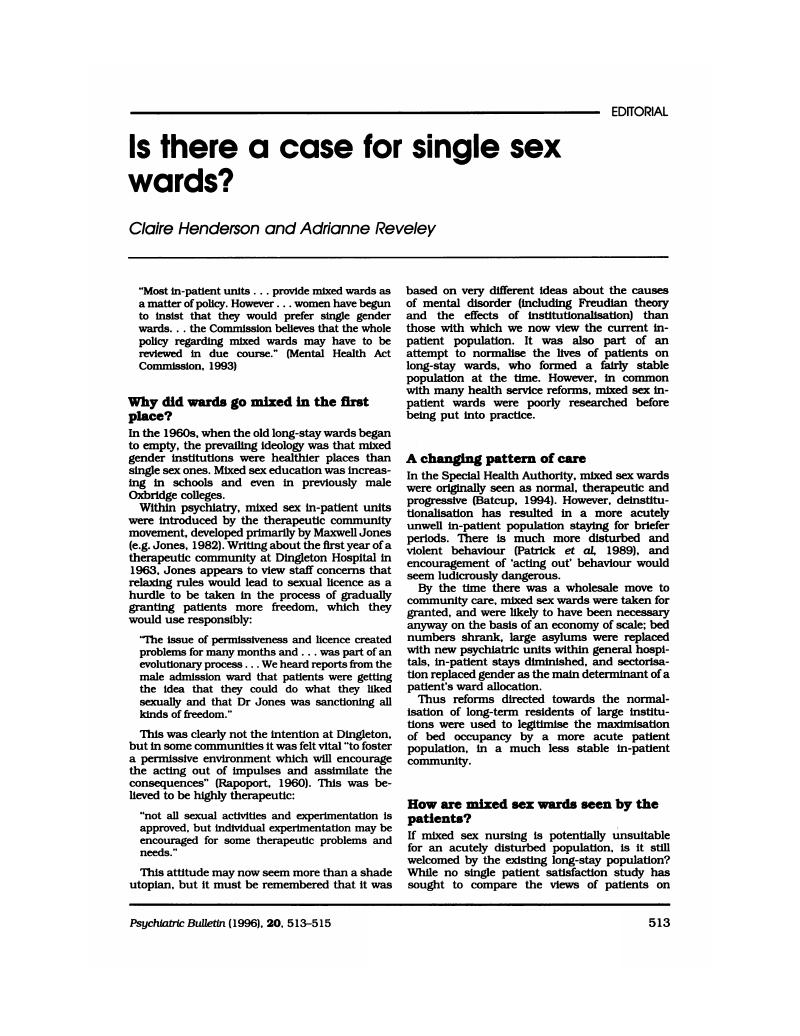Crossref Citations
This article has been cited by the following publications. This list is generated based on data provided by Crossref.
Kohen, Doro
1999.
Specialised in-patient psychiatric service for women.
Psychiatric Bulletin,
Vol. 23,
Issue. 1,
p.
31.
Killaspy, Helen
Dalton, Joy
McNicholas, Shirley
and
Johnson, Sonia
2000.
Drayton Park, an alternative to hospital admission for women in acute mental health crisis.
Psychiatric Bulletin,
Vol. 24,
Issue. 3,
p.
101.
CUTTING, P.
and
HENDERSON, C.
2002.
Women's experiences of hospital admission.
Journal of Psychiatric and Mental Health Nursing,
Vol. 9,
Issue. 6,
p.
705.
Krumm, Silvia
Kilian, Reinhold
and
Becker, Thomas
2006.
Attitudes towards patient gender among psychiatric hospital staff: Results of a case study with focus groups.
Social Science & Medicine,
Vol. 62,
Issue. 6,
p.
1528.
Määttä, Sylvia
2009.
Exploring Male and Female Patients' Experiences of Psychiatric Hospital Care: A Critical Analysis of the Literature.
Issues in Mental Health Nursing,
Vol. 30,
Issue. 3,
p.
174.
Thomas, Neil
Hutton, Jane
Allen, Paul
and
Olajide, Dele
2009.
Changing from mixed-sex to all-male provision in acute psychiatric care: A case study of staff experiences.
Journal of Mental Health,
Vol. 18,
Issue. 2,
p.
129.
Taylor, Tatiana L
Dorer, Gemma
Bradfield, Sarah
and
Killaspy, Helen
2010.
Meeting the Needs of Women in Mental Health Rehabilitation Services.
British Journal of Occupational Therapy,
Vol. 73,
Issue. 10,
p.
477.
Crutchley, Michael
and
O'Brien, Aileen
2012.
Exploration of staff attitudes and experiences towards mixed- and single-sex wards in the National Secure Forensic Service for Young People.
Medicine, Science and the Law,
Vol. 52,
Issue. 4,
p.
210.
Kulkarni, Jayashri
Gavrilidis, Emmy
Lee, Stuart
Van Rheenen, Tamsyn E
Grigg, Jasmin
Hayes, Emily
Lee, Adeline
Ong, Roy
Seeary, Amy
Andersen, Shelley
Worsley, Rosie
Keppich-Arnold, Sandra
and
Stafrace, Simon
2014.
Establishing female-only areas in psychiatry wards to improve safety and quality of care for women.
Australasian Psychiatry,
Vol. 22,
Issue. 6,
p.
551.
Kulkarni, Jayashri
2014.
Women’s mental health: Still not a priority, still not good enough.
Australian & New Zealand Journal of Psychiatry,
Vol. 48,
Issue. 8,
p.
701.




eLetters
No eLetters have been published for this article.